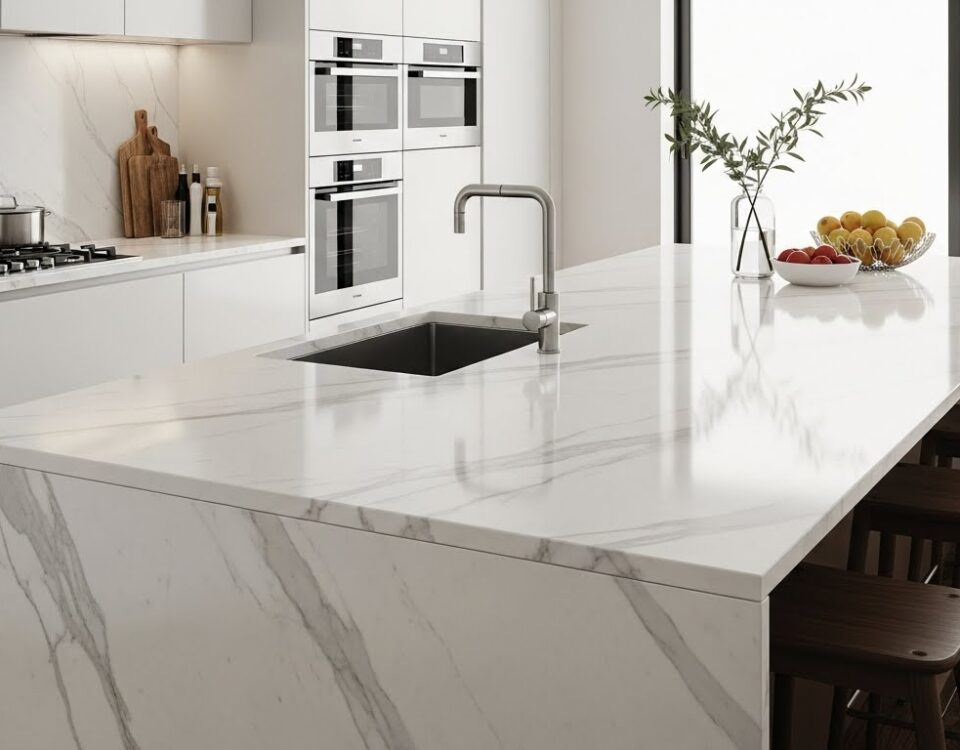The Cost-Effectiveness of Quartz Vanity Tops for Bathroom Renovations
October 23, 2024Porcelain Kitchen Countertops: Care and Maintenance Guide
October 23, 2024Customizing Colors and Patterns for Porcelain Kitchen Countertops
In the realm of kitchen renovations, the customization of porcelain countertops presents a sophisticated opportunity for homeowners and designers alike to express aesthetic individuality. The technology behind porcelain fabrication now allows for an expansive array of color integrations and intricate pattern replications, ranging from natural stone imitations to abstract artistic expressions. This capability not only enhances the visual appeal but also complements the countertop’s renowned durability and stain resistance. As one considers the vast spectrum of customization options, it becomes pertinent to examine how specific hues and designs can influence the overall ambiance and functionality of a kitchen. Exploring this aspect reveals several critical considerations that must be addressed to optimize both utility and stylistic harmony in kitchen spaces.
Understanding Porcelain Countertop Basics
Porcelain countertops, often celebrated for their durability and aesthetic versatility, form an integral component of modern kitchen design. Composed primarily of kaolinite clay, feldspar, silica, and mineral oxides, these countertops are fired at temperatures exceeding 1200°C, resulting in an exceptionally hard and dense surface.
This manufacturing process not only imparts strength comparable to that of granite but also ensures a non-porous finish that resists staining, scratching, and thermal shock. The technical sophistication involved in the production of porcelain slabs allows for a remarkable replication of natural stone patterns, offering a sense of belonging and continuity in kitchen aesthetics.
Moreover, the ability to incorporate various pigments during the fabrication phase facilitates seamless integration into any design palette, enhancing the communal feel of the space.
Choosing the Right Color Schemes
Selecting the optimal color schemes for porcelain kitchen countertops involves a strategic consideration of the overall kitchen ambiance and the interplay of light within the space. To achieve a harmonious balance that reflects both personal style and functional practicality, consider the following key factors:
- Neutral Tones: Utilize shades like beige, gray, or cream for a timeless, versatile appearance.
- Contrast: Pair light countertops with dark cabinetry or vice versa to create visual interest.
- Warm vs. Cool: Decide between warm undertones (reds, yellows) and cool undertones (blues, greens) based on the kitchen’s lighting and existing color palette.
- Color Depth: Opt for deeper hues to add sophistication or lighter shades to enhance spaciousness.
- Complementary Colors: Choose countertop colors that complement other key elements like flooring and backsplash.
Pattern Possibilities for Porcelain Counters
Having explored the impact of color schemes on porcelain kitchen countertops, it’s equally important to consider the variety of pattern options available that can further enhance the aesthetic and functional value of your kitchen surfaces. Porcelain offers remarkable versatility in pattern replication, allowing for intricate designs that mimic natural stone, wood, or even elaborate geometric patterns. This adaptability ensures that each kitchen can exhibit a unique character reflective of personal taste and style preferences.
| Pattern Type | Description | Ideal Use Case |
|---|---|---|
| Veined | Mimics natural stone with flowing lines | Elegant, timeless kitchens |
| Wood-Like | Reproduces wood textures | Warm, rustic settings |
| Geometric | Features bold, repetitive shapes | Modern, contemporary kitchens |
| Custom Artistic | Unique, bespoke designs | Personalized, statement spaces |
Each option offers a distinctive feel, allowing homeowners to craft a space that not only resonates with their identity but also complements the functional dynamics of their living environment.
Read More:


